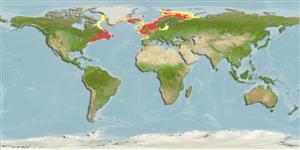Classification / Names
Common names from other countries
Main reference
Size / Weight / Age
Max length : 200 cm TL male/unsexed; (Ref. 1371); common length : 100.0 cm TL male/unsexed; (Ref. 1371); max. published weight: 96.0 kg (Ref. 9988); max. reported age: 25 years (Ref. 173)
Length at first maturity
Lm 63.4, range 31 - 74 cm
Environment
Marine; brackish; benthopelagic; oceanodromous (Ref. 51243); depth range 0 - 600 m (Ref. 1371), usually 150 - 200 m (Ref. 54441)
Climate / Range
Temperate; ? - 15°C, preferred 6°C (Ref. 107945); 83°N - 35°N, 95°W - 86°E (Ref. 1371)
Distribution
North Atlantic and Arctic: Ungava Bay in Canada along the North American coast to Cape Hatteras; North Carolina in the western Atlantic. East and west coast of Greenland; around Iceland; from Barents Sea including the region around Bear Island along the European coast to Bay of Biscay (Ref. 88171).
Countries | FAO areas | Ecosystems | Occurrences | Introductions
Short description
Dorsal
spines
(total): 0;
Dorsal
soft rays
(total): 44-55;
Anal
spines: 0;
Anal
soft rays: 33 - 45;
Vertebrae: 51 - 55. Protruding upper jaw, a conspicuous barbel on the lower jaw, and light lateral line, curved above the pectoral fins. Predorsal distance is less than one third of total length; body depth about 1/5 of total length. Color varies from brownish to greenish or gray dorsally and on upper sides, becoming pale and silvery ventrally. Peritoneum silvery.
IUCN Red List Status (Ref. 115185)
Threat to humans
Harmless
Human uses
Fisheries: highly commercial; aquaculture: commercial; gamefish: yes
Tools
Special reports
Download XML
Internet sources
Estimates of some properties based on models
Phylogenetic diversity index
PD50 = 0.6250 many relatives (e.g. carps) 0.5 - 2.0 few relatives (e.g. lungfishes)
Trophic Level
4.1 ±0.2 se; Based on diet studies.
Resilience
Medium, minimum population doubling time 1.4 - 4.4 years (rm=0.2-1.1; also (Ref. 36717))
Vulnerability
High to very high vulnerability (65 of 100)
Price category
